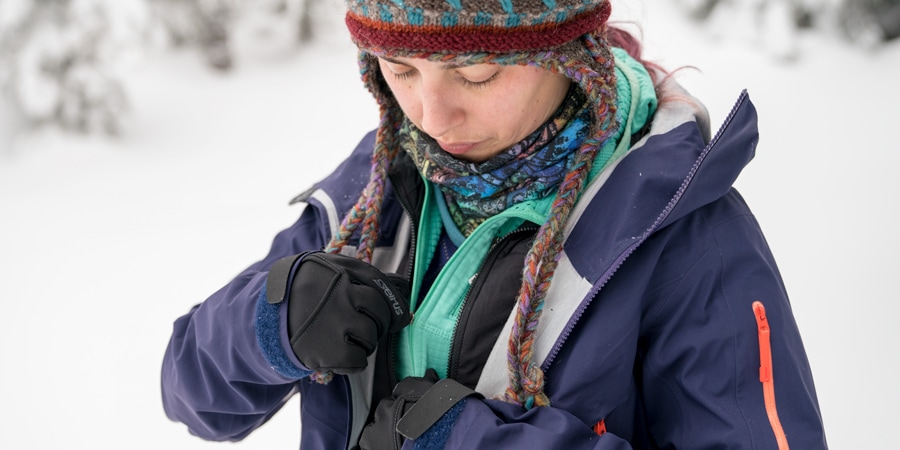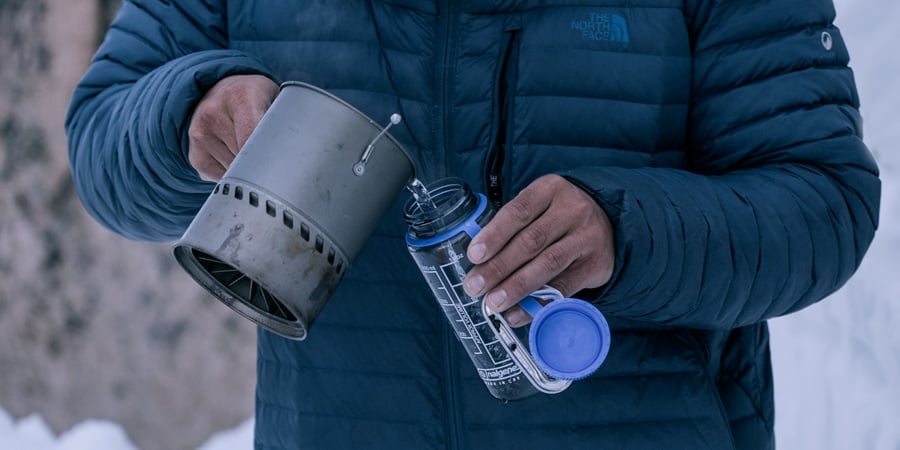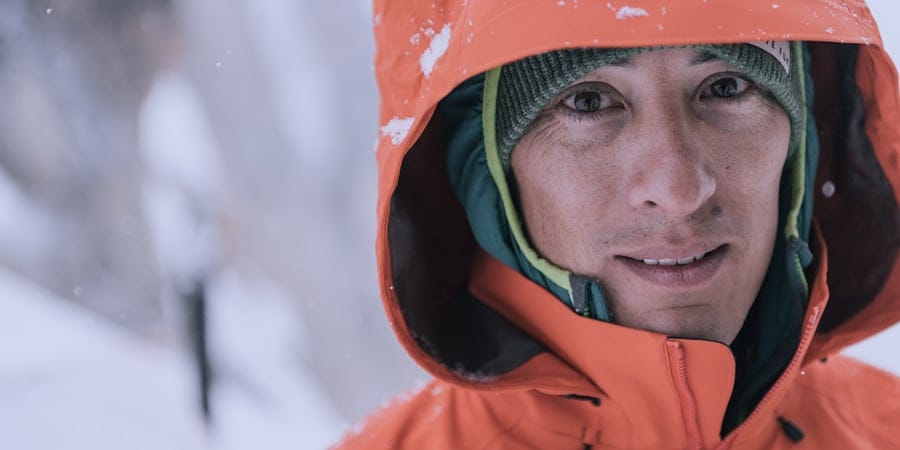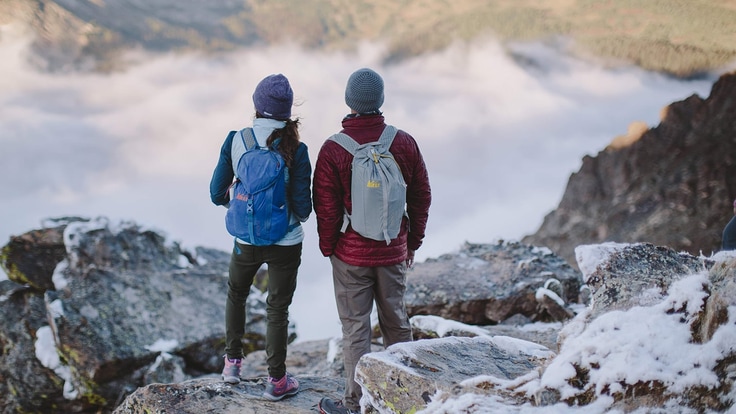It doesn't have to be the middle of winter to make cold weather a concern on your hiking trip. Depending on where you live and where you're hiking, you can encounter cold temperatures any time of year that can make your trip uncomfortable, or worse, cause a serious injury or illness.
To have a more pleasant adventure, first arm yourself with some tips and knowledge for cold-weather hiking, including:
- Proper cold-weather clothing and gear
- Food and hydration
- Cold-related injuries and illnesses
Clothing and Gear Tips for Cold-Weather Hiking

To stay comfortable on a cold-weather hike, it's critical to wear the right clothing and carry the right gear.
Wear layers: Layering is a three-part system that includes a base layer that wicks perspiration away from your skin, a mid layer that insulates you from the cold and a shell layer that keeps wind and moisture out. The goal with layering is to add and remove layers throughout your hike so you can stay warm and comfortable without overheating and getting sweaty. It can feel like a chore to stop and change clothes, but it's really important to stay dry. Getting wet on a cold day can possibly lead to hypothermia.
Learn more in our Layering Basics article and Underwear (Base Layer): How to Choose article.
Say no to cotton: When cotton gets wet, it takes a very long time to dry, which can leave you feeling damp, cold and miserable. Synthetic and wool layers dry much faster and will move perspiration away from your skin.
Cover your skin: Any skin that is exposed to freezing temperatures and cold wind is prone to frostbite. Take special care of your nose, cheeks, ears, fingers and toes.
- For your hands, try wearing lightweight or midweight fleece gloves under waterproof shell mittens or shell gloves. It's also a good idea to bring an extra pair of fleece gloves that you keep stowed in your pack in case the ones you're wearing get wet.
- For your feet, wear synthetic or wool socks that fit well. Thicker socks provide more insulation, but make sure they don't cause your boots to fit too tight, which can cut off circulation. It's also important to keep your feet dry, so carrying an extra pair of socks to change into is a good idea. Wear waterproof boots if you'll be trekking through snow, and if you'll be in very cold temperatures you might require boots with built-in insulation.
- For your nose and cheeks, try a neck gaiter for face mask.
- For your ears, a winter hat or headband can do the trick. A neck gaiter or face mask may also provide coverage for your ears.
Avoid tight clothing: Wristwatch bands, cuffs of gloves, gaiters and boots that are too tight can cause poor circulation, which can increase your chance of getting frostbite. Make sure your clothing and gear fit properly.
Add heat: Hand warmer and toe warmer packets are a great way to warm up your digits, especially if you're prone to cold fingers and toes.
Wear a hat: You can lose heat through the top of your head, so pull a winter hat on if you're feeling chilly.
Keep snow out with gaiters: If your hike will take you through deep snow, gaiters are a must for keeping snow out of your boots. They also add a bit of warmth. Be sure to use waterproof/breathable gaiters for hiking in snow. Learn more in our Gaiters: How to Choose article.
Bring goggles or sunglasses: Always protect your eyes from the sun and wind. Many goggles and some sunglasses allow you to swap lenses in and out so you can select the right lens tint for the weather. Get some tips on buying goggles and sunglasses.
Pack a headlamp: If you're hiking in winter, you'll have less daylight hours, especially if you're in the northern part of the U.S. You don't have to end your trip when the sun goes down, but you must be prepared to hike in the dark. Have a sense for how many hours of usable daylight you have and always pack a headlamp with fresh batteries.
Keep batteries warm: Cold weather can kill batteries quickly. Lithium batteries tend to hold up better in cold temperatures than alkaline batteries, but no matter what battery type you use, it's best if you try to keep them warm. Stowing your headlamp, GPS, cellphone and other electronics in a pocket close to your body can help.
Apply sunscreen: Just because it's cold out doesn't mean you stop worrying about sunburn. In fact, if there's snow on the ground, the sun's rays can reflect back up at you, so you need to be diligent about applying sunscreen on the underside of your nose and chin and around your neck. Learn more in our article about how to use sunscreen.
Bring the Ten Essentials: The Ten Essentials are a collection of items that help outdoor adventurers be prepared for emergency situations. It's wise to take these items along whenever you head out for a hike, but perhaps even more so when exploring in cold weather where consequences of a mishap can be more severe. Learn more in our article about the Ten Essentials.
Video: What to Wear Backpacking and Hiking in the Winter
Food and Hydration Tips for Cold-Weather Hiking

Your body's metabolism is its best heat source, so you need to keep it fueled up with food and water.
Remember to eat and drink: When it's cold outside, you might be less inclined to stop for food and water. Make it simple by keeping snacks and water within reach so you can eat and sip regularly throughout the day.
Keep food from freezing: Nobody enjoys chomping on a rock-hard energy bar. Foods like candy bars, chocolate, nuts and cheese tend to stay softer than some other items in cold weather. You may have to experiment to figure out the foods you enjoy that will stay edible in cold weather. Whatever you choose to bring, stowing food close to your body will help keep it thawed.
Don't let your drink tube freeze: If you use a hydration reservoir, you need to keep the drink tube from freezing or else you'll be left with no way to access your water. To solve for this, many reservoir manufacturers make specific items to insulate the tube and bite valve. Some handy hikers have made their own insulation system with some inexpensive foam from a hardware store. Also, try these tips to keep your tube from freezing:
- Sip often to prevent water from freezing solid.
- After drinking, blow back into the reservoir to keep the tube empty.
Use water bottles: In very cold temperatures, you may need to give up the hydration reservoir and use water bottles because the chance of your drink tube freezing is too high. But, bottles can freeze, too, and it usually happens from the top down, which means the bottle tops are prone to getting stuck shut. Flipping your bottles upside down will solve that problem (just be sure your bottles don't leak and that the tops are screwed shut securely). Putting the bottles in your pack rather than in exterior pockets will help insulate them from the cold.
Another option is to buy insulated sleeves for your water bottles.
Pack warm drinks: Fill up a vacuum-insulated bottle with hot tea or hot chocolate to sip on when you take a break. The warmth goes a long way toward keeping you comfortable.
Learn more about staying properly hydrated in our Hydration Basics article.
Cold-Related Injuries and Illnesses

Your primary health concerns while hiking in cold weather are frostbite and hypothermia.
Frostbite
Frostbite is the freezing of tissue. It's most common on fingers, toes and ears. There are three levels of frostbite: frostnip, superficial frostbite and deep frostbite. All three can look the same while frozen, so it can be difficult to tell how extreme frostbite is until after the skin has thawed.
Signs of frostbite:
- Skin is cold, waxy and pale
- You may feel tingling, numbness or pain in the affected area
- Your skin can feel soft if partially frozen or hard if frozen
- After thawing, blisters often form with superficial and deep frostbite
Treatment of frostbite:
Frostnip, the mildest form of frostbite, can be treated by covering up the exposed skin and taking the time to warm the affected area. Placing cold fingers in your armpits or toes on a partner's warm belly are both effective techniques. Do not rub the cold skin or place it under hot running water because the tissue is very susceptible to damage.
If the treatment for frostnip results in blistering, then it's likely you have superficial frostbite or deep frostbite. It's best to get to a doctor for treatment as soon as possible. As with frostnip, avoid hot water that can burn and don't rub the injured area as that can damage the tissue. After thawing you need to be very careful to not let the area refreeze.
Hypothermia
Hypothermia is the result of the body's temperature dropping below normal. Some people assume hypothermia only happens in winter, but a cold rain or the frigid temperature of a rushing river can be enough to cause it. Hypothermia can be life threatening and must be taken seriously.
Signs of mild hypothermia:
- Shivering
- Minor clumsiness (eg. trouble operating zippers)
- Slow thinking, confusion, change in mood
Signs of moderate hypothermia:
- Intense shivering
- Obvious change in coordination (e.g. stumbling, falling)
- Obvious change in mental status (e.g. irritability, forgetfulness)
Severe hypothermia:
- Shivering may stop due to energy depletion
- Further deterioration of mental status (e.g. disorientation, irrational behavior)
- Pulse may be undetectable
Treating hypothermia:
The first step in treating hypothermia is to change the hiker's environment. That means if you can get the person indoors, do so. If you're outside and far from shelter, do what you can to get away from whatever is causing the cold stress, such as getting out of the wind and off of snow. If the hiker is wearing wet clothing, swap it out for dry clothes and make sure the hiker is well-insulated. Give the person water and food so they have enough energy to shiver, which is your body's natural way of producing more heat.
With the right treatment, hikers with mild hypothermia can possibly recover and continue on the trip. Hikers with moderate and severe hypothermia should be treated and evacuated as soon as possible.
Preventing Frostbite and Hypothermia
To prevent frostbite and hypothermia you need to actively take care of yourself and your hiking partners. Many of the tips listed above about clothing, gear, food and hydration apply, but here are some additional things to think about:
Stay warm: It's so much easier to stay warm than to get warm. By dressing appropriately, you can maintain a comfortable temperature, which is much simpler than trying to warm up after getting too cold.
Don't try to tough it out: If you feel your fingers or toes getting cold, stop and take the time to check on them and warm them up. Placing cold fingers in your armpits or cold toes on a partner's warm belly are good ways to warm up. Using hand warmer and toe warmer packets is also effective.
Keep an eye on your friends: A good hiking partner keeps an eye on their buddies. Regularly ask your friends how they're doing and if you see pale spots on your friend's face or they're starting to get clumsy on the trail, make them stop and cover up exposed skin or add a warm insulating layer.


